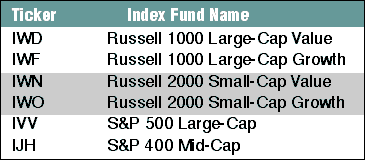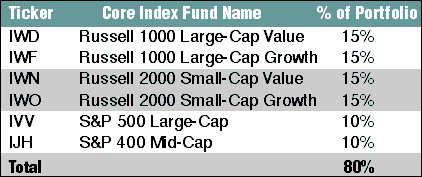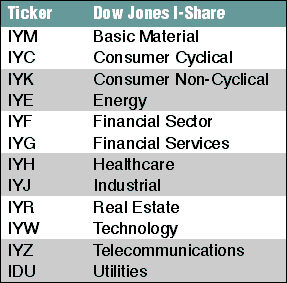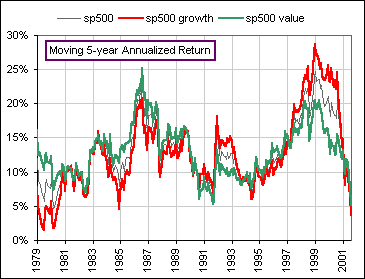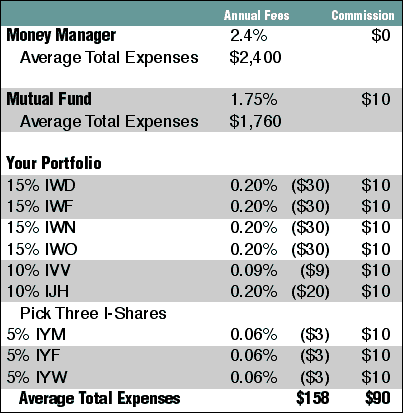
HOT TOPICS LIST
- Strategies
- Stocks
- Buy
- Investing
- Brokers
- Psychology
- Interviews
- Accumulate
- Sell
- Hold
- Spotlight
- Websites
- Candlestick Corner
- Gold & Metals
- Options Trading
LIST OF TOPICS
INVESTING
A Five-Step Market Portfolio
10/06/04 09:41:55 AM PSTby Andy Hicks
Here's a simple five-step investment process that can help you participate in the market without paying those exorbitant mutual fund or manager fees and limiting downside risk.
| Professional education titles attached to portfolio managers' signatures, such as MBA (master's degree in business administration), CFA (chartered financial analyst), and CFP (certified financial planner), should not hype investors into hiring money managers. In fact, statistics show only one in 36 money managers beat their performance benchmarks on a historical basis. With a simple five-step investment process, investors can participate in the market without paying the extraordinary mutual fund or manager fees, while also limiting the downside risk that can often occur when a money manager deviates from its benchmark.
1. When: You Make The Call Most money managers don't time the market and will invest your money as soon as possible to receive your fees. So you make the call. Consider the time horizon of your money. If it is more than five years, invest your money today because nobody can predict the market five years from now. If it is fewer than five years, consider the economy relative to the stock market. The stock market is a leading indicator of the economy, so respect the economic cycles. For your initial investment, invest (buy) your money in the market after an S&P 500 Barra Growth (SGX) absolute downturn of more than a year, and stay clear (sell) after an S&P 500 Barra Growth absolute upturn of more than two years (explained further in Step. 4) The S&P 500 Barra Growth Index has more of a technology weighting, which generally tends to lead overall economic cycles.
2. Who: Do Not Use A Stockbroker/Financial Advisor By the time stockbrokers learn about their firm's research, it's already priced into the stock, but investors still pay higher commissions based on this stale research. Historically, these analyst research calls can be motivated by investment banking deals within the same securities firm. As long as there are huge initial public offering (IPO) and secondary offering fees paid to broker/dealers, the "Chinese wall" (a set of procedures enforced within a securities firm to separate equity analysts from investment bankers, with the goal of avoiding possible conflicts of interest) will be paper thin, regardless of the law. So be wary of analyst calls and certainly don't pay for them in your trading commissions. In addition, with the institution of regulation FD, portfolio managers and financial advisors can no longer question company officials for nonpublic information. This used to be a value-added tactic, but after its ban, the higher manager fees and trading commissions can longer be justified.
3. What: Allocate An Array Of Index ETFs (Electronically Traded Funds) Money managers use the Russell and the S&P indexes to benchmark their diverse portfolios. But diversification can be attained by indexing across all industries and sectors of small to large capitalization using index electronically traded funds (ETFs) with a growth and value approach. There will be overlap of some stocks held in more than one of these index funds, but the overweighting will be insignificant. So here's your index ETF portfolio (see Figure 1).
Figure 1: Index ETF portfolio
4. Why: A Core Allocation Minimizes Your Risk A typical money manager will invest 95% of the portfolio and keep 5% cash. Based on your initial cash invest ment, this is how your core portfolio should be allocated (see Figure 2).
Figure 2: Recommended allocation of your core portfolio
To become 95% invested, 15% will be invested in Dow Jones (industry) I-shares, which are similar to index funds but invest in a basket of same-industry Dow stocks. This reduces company-specific risk of individual stocks. Choose three of the I-Shares listed in Figure 3 based on an industry up-cycle or a stock you like in the industry, and allocate 5% to each I-Share. Sell an I-Share after a one-year high above your purchase price, and invest in another up-cycle I-Share.
Figure 3: Your choice of I-Shares
Generally, growth stocks outperform value stocks in a rising market, whereas value stocks generally outperform growth stocks in a down market (see Figure 4).
Figure 4: Growth stocks vs. value stocks. Generally, growth stocks outperform value stocks in an up market, whereas value stocks outperform growth stocks in a down market. Since growth stocks are priced to represent the market future, and value stocks are priced to represent the market fundamentals, the growth index is a better gauge for trading your portfolio. When you apply the rule from step 1, you will sell your Russell Large or Small Cap Growth Index fund after two years and a gain, and repurchase after a downturn of over a year. When you sell your Russell Large or Small Cap Growth Index, you will overweight the Russell Large or Small Cap Value Index in anticipation of a downturn. This acts as a defense mechanism. For example, if you wanted to invest in late 1989, you would have waited to invest until late 1990, a downturn of over a year. Growth stocks continued to slide through late 1991, but after an upturn of two years and a gain, you would have sold your Russell Large and Small Cap Growth stocks in late 1992. At that point, you would have reinvested those proceeds to overweight your Russell Large and Small Cap Value Index funds. After the downturn of over a year in 1993, where value outperformed growth stocks, you would have rebalanced your portfolio into the normal weighting of Russell Large and Small Cap Growth Index funds in late 1993. Here's another example: if you wanted to invest in 1995 or 1996, you would have, because the S&P 500 Barra Growth was essentially flat in absolute terms (not a downturn of over a year, or an upturn of over two years). On both 1995 and 1996 investments, after an upturn of two years and a gain, you would have sold your Russell Large and Small Cap Growth and reinvested those proceeds to overweight your Russell Value Index funds in 1998. Or, if you wanted to invest in 1997, the S&P 500 Barra Growth already had an upturn of one year, so you would have invested and subsequently sold your Russell Large and Small Cap Growth Index funds in 1998 after an upturn of two years and a gain, and used those proceeds to overweight your Russell Value Index funds. This general rule is consistent with any year after an S&P 500 Barra Growth downturn of over a year, or any year after an upturn of two years from 1979 to 2003, except for the anomalous years of 1998 to 2001. During that period of unfeasible valuations, chaotic volatility, and subsequently a dramatic market collapse, neither growth nor value stocks performed logically. However, this is why investment time horizons of more than five years can withstand these random market blips.
5. How: Open Your Online Account Never pay more than $10 per trade. Many online trading brokerages offer index and I-Share trading for less than $10 per trade. In addition, inquire about the interest rate you will receive on your free cash balance. Most online brokerages won't offer interest rates higher than the going money market, so in times of large cash positions, transfer the money into a savings account. Example: Assume a $100,000 portfolio (Figure 5). An average annual manager fee runs around 2.4%, and commissions are not charged on any trades. Comparably, an average annual mutual fund expense ratio is 1.5% of assets, plus 12b-1 fees (0.25%). This does not include the trade commission, and the potential one-time redemption fee (1.54%) or annual sales load (4.5%), if any. We will assume no redemption fee or sales load for this example, but they are very common for mutual funds.
Figure 5: Your $100,000 portfolio. Expenses and fees of mutual funds and hiring a money manager are factors that need to be considered when investing.
Your diversified $100,000 portfolio will cost you $248 initially, with absolute control of your investment assets and no annual sales or redemption fees. Conversely, if you hire a money manager, you will pay $2,400 annually on a $100,000 investment, or if you buy a mutual fund, you will pay a minimum of $1,760 annually on a $100,000 investment. With more than 80% of mutual funds underperforming the market indexes, and only one in 36 money managers beating their respective S&P or Russell benchmarks on a historical basis, there's no need to pay more for this chance performance. Investing with index ETFs and I-Shares is the most efficient and safe way to play the stock market.
Andy Hicks is a licensed investment professional with experience as an equity trader and an analyst research associate. He may be reached at hicksak@yahoo.com.
Current and past articles from Working Money, The Investors' Magazine, can be found at Working-Money.com. |
| E-mail address: | hicksak@yahoo.com |
PRINT THIS ARTICLE

|

Request Information From Our Sponsors
- StockCharts.com, Inc.
- Candle Patterns
- Candlestick Charting Explained
- Intermarket Technical Analysis
- John Murphy on Chart Analysis
- John Murphy's Chart Pattern Recognition
- John Murphy's Market Message
- MurphyExplainsMarketAnalysis-Intermarket Analysis
- MurphyExplainsMarketAnalysis-Visual Analysis
- StockCharts.com
- Technical Analysis of the Financial Markets
- The Visual Investor
- VectorVest, Inc.
- Executive Premier Workshop
- One-Day Options Course
- OptionsPro
- Retirement Income Workshop
- Sure-Fire Trading Systems (VectorVest, Inc.)
- Trading as a Business Workshop
- VectorVest 7 EOD
- VectorVest 7 RealTime/IntraDay
- VectorVest AutoTester
- VectorVest Educational Services
- VectorVest OnLine
- VectorVest Options Analyzer
- VectorVest ProGraphics v6.0
- VectorVest ProTrader 7
- VectorVest RealTime Derby Tool
- VectorVest Simulator
- VectorVest Variator
- VectorVest Watchdog

